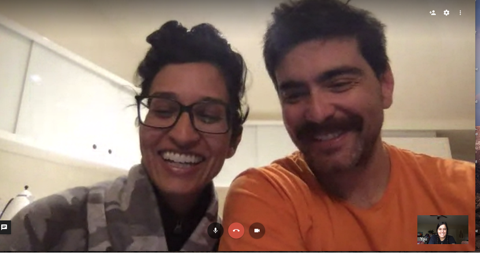An interview with Raqi Syed and Areito Echevarria, Auckland, NZ
As a follow-up to “Impact of Covid-19 on Immersive Creatives,” an article I wrote nearly 100 years ago, way back in March, I’ve continued to talk to artists about their pandemic experiences. With three months under our belts, we are used to social distancing and stay-at-home orders (almost). Wearing a mask outside no longer phases us. And, we’ve started to see a “new normal” emerge in our personal and professional lives as we continue to shelter in place.
See other discussions with Nancy Lee, Diego Galfassi, and Stephanie Dinkins.
 Raqi Syed
Raqi Syed Areito Echevarria
Areito EchevarriaWhen the pandemic broke out, Raqi Syed and Areito Echevarria were in the final stages of launching their virtual reality project, MINIMUM MASS, about a couple who experience a series of miscarriages and come to believe their children are being born in another dimension. MINIMUM MASS is a 20-minute experience that takes place in a real-time, photorealistic computer-generated story world; it has been developed for the Oculus Rift-S.
At the time, they had just received their third-party, motion-capture facial data and were getting ready to do the final binaural sound mix. They had been working with a Los Angeles-based composer.
“These things are difficult to do remotely because of all the lag,” says [which one?] “We have remote desktop access to our studio, but we can’t physically be in there. We’ve got less than 10%, maybe 5%, left to go on the project before it’s complete, but we just haven’t been able to push through.”
Tribeca Film Festival Immersive launched the 360 VR component of MINIMUM MASS as part of its online Virtual Arcade, but the interactive pieces could not be released online. Tribeca did host an online marketplace for creators, which allowed the pair to meet people and talk through the projects and the future:
“The Americans and the Europeans have very different ideas about how we are going to emerge after Covid.” [says which one?]The Americans have specific fears regarding physical contact with the VR headsets, while the Europeans don’t have so much resistance:
“I think a lot of it has to do with how space is understood in different places. In America, we’ve always had more space…” says Syed.
Because they’re based in New Zealand, they face additional challenges“It looks like the border is going to remain closed for the foreseeable future. So even if everyone is able to return to daily normal life, nobody will be able to leave, or enter, the country,” says Echevarria. This makes attending festivals impossible. What does a festival premiere look like when the directors are not physically present?
We are working on an experimental documentary about empathy, which has been long-listed for IDFA in Amsterdam. But is there a point in premiering it at IDFA if we can’t go and meet people?” Echevarria asks.
So far, they have been able to weather the economic turmoil.
“I think we are in a relatively fortunate state so far,” says Syed. “We are academics and our research, which is our creative practice, is partially funded through the University.”
However, it’s unclear how long this will last. “It’s somewhat ironic because we left the film industry to become academics because it was a more stable career option, but… there’s been talk about redundancies, pay-cuts, and this kind of thing, so it’s very uncertain,” reflects Echevarria.
 Raqi, Areito, and Paisley Skyping
during their conversation :)
Raqi, Areito, and Paisley Skyping
during their conversation :)Immerse is an initiative of the MIT Open DocLab and The Fledgling Fund, and it receives funding from Just Films | Ford Foundation and the MacArthur Foundation. IFP is our fiscal sponsor. Learn more here. We are committed to exploring and showcasing media projects that push the boundaries of media and tackle issues of social justice — and rely on friends like you to sustain ourselves and grow. Join us by making a gift today.